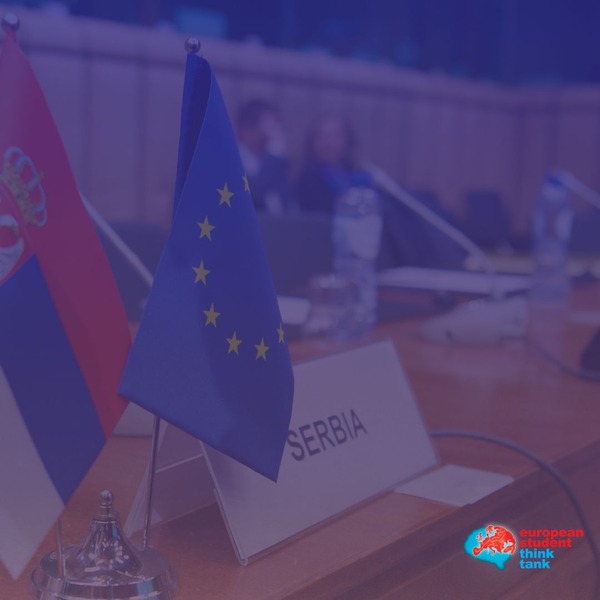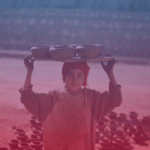
Written by: Anastasia Stanković, Faculty of Social Sciences, University of Ljubljana
Edited by: Mirko Rosa
Introduction
Compared to its post-communist neighbours, Serbia has taken a different path in its transition to democratisation. Despite the brevity of their previous initiatives, students have emerged as a new driving force, reawakening European values and the struggle for democracy, both of which were on the verge of disappearing in the country.
The critical turning point for Serbia was the 5th of October 2000, which marked the defeat of former president Slobodan Milošević. Now freed from the chains of dictatorship, Serbia entered a phase of EU-oriented reform, with European integration, the rule of law, and human rights established as its ultimate guiding principles (Kostovicova, 2004). Prime Minister Zoran Djindjić emerged as the symbol of this transformation until his assassination in 2003, a tragedy that marked a dark time in Serbia and the end of the democratic reform and change momentum (Pavlović, 2019).
Serbia applied for EU membership in 2004 but only attained candidate status in 2012. Moreover, that year marked the beginning of the Serbian Progressive Party’s dominion of national politics which continues to the present day, bolstered by EU support. In 2012, Serbia seemingly entered an endless limbo that can be described as a state of hibernation. Citizens stopped engaging in civic life or participating in any movement and Belgrade embarked on an authoritarian trajectory characterised by media suppression, corrupted institutions, and an apparent opposition incapable of posing a real threat to the regime.
Between 2024 and 2025, mass student demonstrations against the ruling party re-emerged in Serbia. This article aims to analyse how the student protests are testing European values, which in the case of Serbia appear to be dual. It will focus on the EU’s tendency to maintain good relations with the president for its own interests, even at the cost of compromising the country’s democratic development.
The Student Movement 2024-2025
The event that sparked the ongoing revolutionary movement in Serbia was the collapse of the upper structure at a train station in Novi Sad, resulting in the deaths of 16 people, including both children and adults. On November 5th, 2024 around 22.000 citizens massed to commemorate the victims and demanded that the authorities take responsibility for such a tragedy. The event sparked a chain of social mobilisation, which began demanding more transparency in the actions of institutions (Djurdjić, 2024).
The student blockades of faculties around Serbia began in Belgrade, at the Faculty of Dramatic Arts. On November 22th, students of this faculty peacefully gathered to pay their respects to the victims, at precisely 11:52 – the exact time when the Novi Sad disaster occurred – however, this event ended in violence by an unknown organized group of citizens, who later turned out to be members of the Serbian Progressive Party (N1 Beograd, 2025). The violence occurred during a 15-minute silence that lasted from 11:52 a.m. to 12:07 p.m. (Nova RS, 2024). A few days later, the same students and the whole faculty, with the support of professors, closed the institution for good. Following this initiative, day after day, all faculties of the University of Belgrade, the University of Novi Sad, and the University of Niš initiated the blockade (Marinković & Kljajić, 2025).
With protests escalating, students made four demands to the competent institutions: publishing the documentation on the reconstruction of Novi Sad railway station, demanding the identification and prosecution of those who violently attacked students and professors at any protest, and cancelling all criminal charges against protest participants. They also required a 20% increase in university funding (Studentski Zahtevi, n.d.).
EU’s Support to the Ruling Party
The EU has established a basic framework of conditionality for candidate countries, primarily focused on EU values, including human rights and democratic governance. In the case of Serbia, the EU has demonstrated a greater commitment to the geopolitical stability of the Western Balkans than to upholding human rights within the country. Here, the dual role of EU values in maintaining stability has indirectly contributed to a lowering of the standard of human rights enforcement in Serbia. Progress reports on the media have mainly highlighted suppressed media freedom and freedom of expression, but the EU has not exerted the same pressure as it has on other candidate countries. On the legal front, laws intended to uphold the implementation of fundamental human rights have proven inadequate, leading to widespread scepticism about the EU’s influence in Serbia (Huszka, 2018).
The EU’s support for the ruling party can be seen through several dimensions, including political, economic and social aspects that are supposed to bring Serbia closer to EU values. Through the lens of the EU, the ruling party, which has held its position since 2012, plays a complex role both as a promoter of stability and a potential obstacle for genuine EU integration. The biggest obstacle to Serbia’s integration are its foreign policy, which attempts to balance relations with Russia and China alongside aspirations for EU membership, and Vučić’s government which faces criticism for the erosion of democracy and the rule of law in the country. Despite this, the EU is maintaining close cooperation with the ruling party in hopes that it will lead to the establishment of democratic reforms and reducing euroscepticism by promoting stability and trust among Serbian citizens (Styczyńska, 2025).
The EU’s Silence on Its Greed for Lithium
Even in the case of ongoing students’ protests, the EU showed a lack of coherence and exhibited double standards, which are mainly reflected in Brussels’s late reaction and the lack of media coverage of the events. Through the events, the students have shown that they feel abandoned and that their persistence for European values is being ignored. The EU initially offered minimal verbal support for student protests, which was considered insufficient by the Serbian public (Baccini, 2025).
Following the 2023 parliamentary elections in Serbia, the EU called for dialogue and an investigation into the lack of electoral integrity. Even though this was a year before mass student protests began, Serbian citizens called upon the EU to support student demands. Still, stagnation is evident on the EU side. Despite numerous calls and minimal support for Serbian citizens fighting for fundamental European values, the EU remains relatively silent due to its agendas, which a public indictment of Aleksandar Vučić could undermine (Beširević, 2025).
The EU views the Republic of Serbia as a strategic periphery for the extraction of various natural resources, particularly lithium, which it would utilise for the green transition. The Jadar mine project, which the transnational corporation Rio Tinto has been trying to implement since 2014, could cover 90% of Europe’s lithium needs. The Serbian public saw this as a sacrificial zone and a contribution of the EU to the situation. This project, along with the EU’s need for it, triggered massive demonstrations in the country, where green activists, together with citizens, protested against Rio Tinto. The most significant criticism is that Serbians stressed that their lives should not be in jeopardy for EU environmental benefits (Stuehlen & Andrel, 2024). So, if the EU decided to condemn Aleksandar Vučić fully, it would risk losing access to the lithium that it has at its fingertips in Serbia.
The Rise of Youth Euroscepticism
The widespread distrust of national institutions among the Serbian public stems from a culture of political rejection, rooted in numerous political crises that began in the late 1980s. There is a prevailing belief that politicians prioritize their own interests over the public good. Such a predisposition has led to a high level of apathy and disengagement from political processes. The issue of distrust is multifaceted and influenced by historical, social and political factors (Fiket et al., 2022).
The growing mistrust in government institutions extends to the EU, which is perceived as a remote bureaucracy that imposes regulations without properly addressing local needs or concerns. The rise of youth euroscepticism is primarily a consequence of the country’s current political climate. This form of scepticism is linked to Serbia’s post-communist cultural heritage, marked by a blend of democratic aspirations and persistent authoritarian tendencies. Today, the legacy of nationalism remains prominent, challenging efforts to establish a stable democracy (Styczyńska & Dajč, 2022).
In the current context, young people fighting for fundamental European values observe that the EU primarily emphasises stability in the Balkans, as promoted by President Aleksandar Vučić, which conflicts with their fight, based on completing the democratisation process. Due to the close connection between skepticism and ongoing protests, young people doubt the EU’s role in Serbia. The situation highlights the complex interaction between national and European authorities (Beširević, 2025).
Conclusion
The student protests sparked by the collapse of the canopy in Novi Sad have awakened a demand for systematic reforms, transparency and accountability. These ongoing demonstrations happening in Serbia reflect European fundamental values. At the same time, an analysis of the EU’s role in this context reveals its significant influence on the unfolding events. There is a clear need for greater EU involvement in current events, which would help connect with pro-European youth. However, given the EU’s current stance towards the protesters, it appears that Euroscepticism in Serbia will likely persist as a value transmitted from generation to generation.
The Centre for European Policy Analysis suggests the following measures for greater EU involvement in the developments in Serbia:
− The EU should publicly condemn the repressive measures, as this will give legitimacy to the student protests and prevent the undermining of democratic freedoms.
− It should offer financial and legal assistance to all NGOs and student movements working to achieve democratic and rule of law reforms.
− It should encourage the opening of a dialogue between the Serbian authorities and civil society, with the primary goal of fostering a constructive dialogue (Alizoti & Hartwell, 2025).
The EU is currently at a crossroads. Maintaining close relations with President Vučić and prioritizing stability, regardless of the cost, may push away the pro-European youth who defend the EU’s fundamental values. While Brussels is aware that fully supporting student protests in Serbia risks destabilising the region, its current approach is not without consequences.
The perception of double standards has rapidly spread among the public, significantly eroding trust in the integration process. Despite the EU’s continued support for the ruling party, maintained despite recent developments, President Vučić’s government has exploited criticism of the EU and public skepticism to stir nationalist sentiments. The narrative has been turned into a case of interference in national sovereignty, further contributing to the growing sentiment of euroscepticism among Serbian citizens. Without increased pressure on the Serbian authorities, the EU risks paying a far greater price than access to lithium, as such behaviour could ultimately undermine its own foundational values in the long term (Huszka, 2017).
References
Alizoti, A., & Hartwell, L. (2025, May 1). How the EU Can Help Serbia’s Protesters. CEPA. https://cepa.org/article/how-the-eu-can-help-serbias-protesters/
Baccini, F. (2025). Students in Serbia are losing faith in the EU, but not in European values. The Parliament Magazine. https://www.theparliamentmagazine.eu/news/article/students-in-serbia-are-losing-faith-in-the-eu-not-in-european-values
Beširević, V. (2025, February 18). What Madonna Got and the EU Did Not: Students’ Uprising in Serbia. Verfassungsblog. https://verfassungsblog.de/what-madonna-got/
Djurdjić, S. (2024). Nadstrešnica i nevidljivi javni tužioci. https://pescanik.net/nadstresnica-i-nevidljivi-javni-tuzioci/
Fiket, I., Draško, G. P., & Urošević, M. (2022). Anti-politics as ‘culture of rejection’: the case of Serbia. Patterns of Prejudice, 56(4–5), 279–296. https://doi.org/10.1080/0031322x.2023.2228575
Huszka, B. (2017). Human Rights on the Losing end of EU Enlargement: The Case of Serbia. JCMS Journal of Common Market Studies, 56(2), 352–367. https://doi.org/10.1111/jcms.12604
Kostovicova, D. (2004). Post-socialist identity, territoriality, and European integration: Serbia’s return to Europe after Milošević. GeoJournal, 61(1), 23–30. https://www.researchgate.net/profile/DenisaKostovicova/publication/240478890_Post socialist_identity_territoriality_and_European_integration_Serbia%27s_return_to_Eu rope_after_Milosevic/links/5e71eb1b4585152cdbfab55b/Post-socialist-identity territoriality-and-European-integration-Serbias-return-to-Europe-after-Milosevic.pdf
Marinković, L. & Kljajić, K. (2024). Studenti blokirali fakultete u Beogradu. BBC News. https://www.bbc.com/serbian/articles/ce8j24q8687o/lat
N1 Beograd (2025, May 6). Osam meseci uslovno i 80.000 dinara za napadača na studente ispred FDU. N1 Info RS. https://n1info.rs/vesti/osam-meseci-uslovno-i-80-000-dinara-za-napadaca-na-studente-ispred-fdu/
Nova.Rs. (2024, November 22). Tuča demonstranata i vozača kod FDU, napadnuta i novinarka Nova.rs. N1. https://n1info.rs/vesti/tuca-demonstranata-i-vozaca-kod-fdu-napadnuta-i-novinarka-nova-rs/
Pavlović, D. (2019). The political economy behind the gradual demise of democratic institutions in Serbia. Southeast European and Black Sea Studies, 20(1), 19–39. https://doi.org/10.1080/14683857.2019.1672929
Stuehlen, C., & Anderl, F. (2024). Transnational companies in environmental conflicts: Rio Tinto, anti-mining resistance in Serbia, and the contradictions of Europeanization. Zeitschrift Für Friedens- Und Konfliktforschung. https://doi.org/10.1007/s42597-024-00114-5
Studentski zahtevi. (n.d.). Zahtevi studenata u blokadama. https://studentskizahtevi.rs/lat/
Styczyńska, N., & Dajč, H. (2022). Between the past and the future, Eurosceptic political parties and the EU integration of Serbia. In Berti F. & Sondel-Cedarmas J. (Eds.), The Right-Wing Critique of Europe. Routledge. 146-159. https://api.taylorfrancis.com/content/chapters/oaedit/download?identifierName=doi&identifierValue=10.4324/9781003226123- 14&type=chapterpdf
Styczyńska, N. (2025). Serbia and the European Union: A decade of negotiating challenges (2014–2024). Przegląd Politologiczny, 4, 331–342. https://doi.org/10.14746/pp.2024.29.4.21

 The ’Ndrangheta’s Infiltration and Threat to European Institutions
The ’Ndrangheta’s Infiltration and Threat to European Institutions  From Paper to Practice: How Grassroots Norms Undermine Gender Rights in Pakistan
From Paper to Practice: How Grassroots Norms Undermine Gender Rights in Pakistan  Exploited Childhoods: The Role of Global Corporations in Perpetuating and Mitigating Child Labour
Exploited Childhoods: The Role of Global Corporations in Perpetuating and Mitigating Child Labour  Human Rights Challenges in Addressing SLAPPs in Media, NGOs and Journalism in the EU
Human Rights Challenges in Addressing SLAPPs in Media, NGOs and Journalism in the EU 


